Droplet Mobility on Fibrous Surfaces
| Coating a surface with hydrophobic fibers can serve as a cost-effective alternative to micro-fabricating a hydrophobic roughened surface, a surface characterized by high apparent droplet contact angles. Fibrous coatings are usually made by depositing layers of randomly orientated fibers on top of one another, and while a droplet can exhibit a high apparent contact angle on such surfaces, its adhesion to the surface may still be quite strong and/or unpredictable. The reasons behind droplet adhesion to a hydrophobic fibrous surface has not yet been fully understood or formulated. Our research in this area is aimed at quantifying the force of adhesion between a droplet and a hydrophobic surface. In particular with this research, we investigate the force required to detach a droplet from a hydrophobic fibrous surface both experimentally and computationally. Electrospun Polystyrene mats were considered for our study as they exhibit both high contact angles and poor droplet mobility. As the earth gravity is not strong enough to detach small droplets from such surfaces, aqueous ferrofluid droplets were used in a controllable magnetic field to enhance the effect of gravity. The detachment process was recorded via a high-speed camera and the images were used to detect the moment of detachment and to analyze droplet shape before and during detachment, as can be seen in the figure below and in Video 1. |
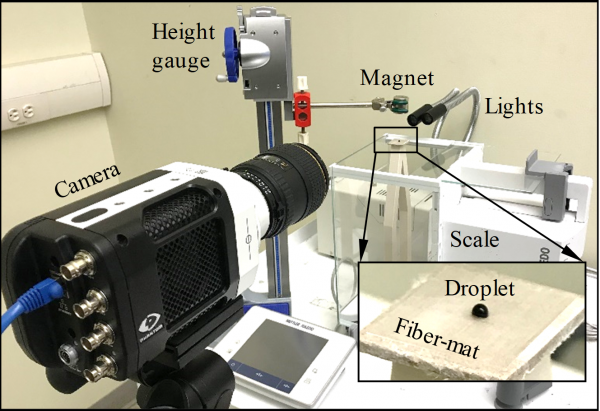 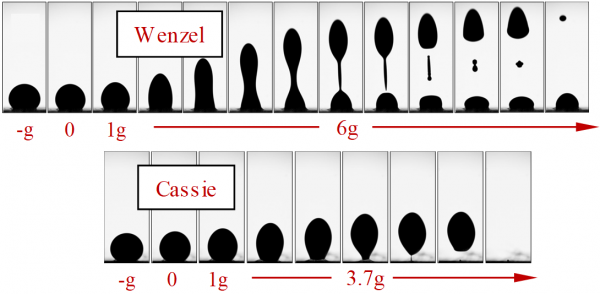
Our experimental setup is shown in the figure on the left. Snapshots of the droplet detachment process are shown in the right figures. The net force (per unit mass) acting on the droplet is given under the images for each case in unit of g (gravitational acceleration). Both the Wenzel (wetting) and Cassie (non-wetting) droplets are shown [Jamali et. al., 2018a]. Video 1: Droplet Detachment from An Electrospun PS Surface – Wenzel Droplet |
| A series of experiments similar to those shown above were also conducted for droplet moving over the surface of the electrospun PS coatings. Both the Wenzel and Cassie droplets were produced and used in the experiment as can be seen in figures below and Videos 2 and 3. |

Example snapshots of droplet deformation and sliding are also shown for Wenzel and Cassie droplets with a volume of 4 μL. The force applied on the droplet is shown above each figure in unit of gravitational acceleration [Jamali et. al., 2018b]. Video 2: Droplet Mobility on An Electrospun PS Surface – Cassie Droplet Video 3: Droplet Mobility on An Electrospun PS Surface – Wenzel Droplet |
| Using a combination of numerical simulation (see the figure below) and experiment, we were able to produce an easy-to-use expression for the body force required to vertically detach a droplet from a electrospun PS surface, or make roll over the surface. The graph shown below compares predictions of our new equations to those obtained experimentally for droplet vertical detachment as a function of fiber-fiber spacing (inversely proportional to electrospinning time). |
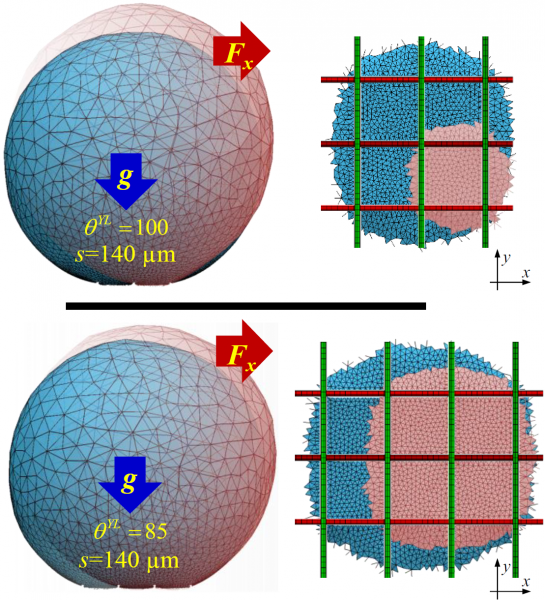 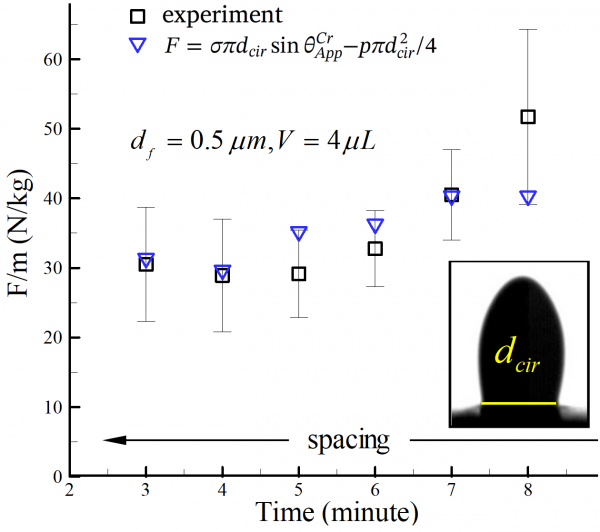 Droplet profile and bottom views (droplet footprints) are given in the figures on the left for a droplet on a hydrophobic fibrous surface. The blue droplet is under gravity while the red droplet is pulled to the right. The YLCA for the droplet in the upper and lower rows are 100 and 85 degrees, respectively [Jamali et. al., 2018b]. The plot on the right is comparison between droplet detachment force in the vertical direction versus fiber-to-fiber spacing (inversely proportional to electrospinning time) obtained from our easy-to-use equation and experimental data [Jamali et. al., 2018a]. |
| We also conducted a similar computational-experiment study for droplets deposited on coated wire screens used for droplet separation (see the figures below and Video 4). The plot shown below compares droplet roll-off angle obtained from our simulations with those measured experimentally. |
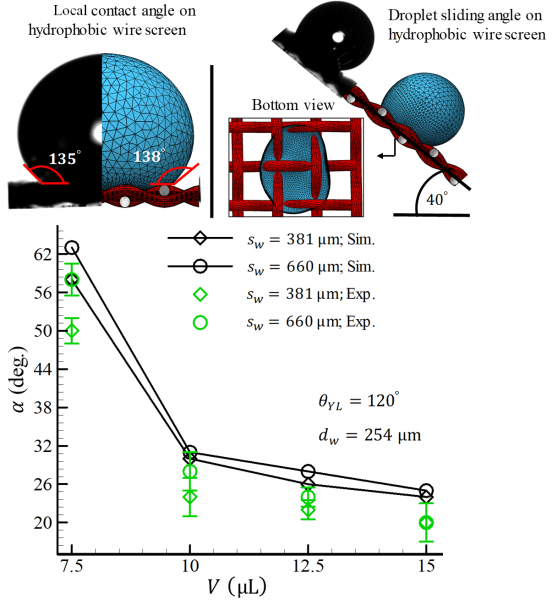 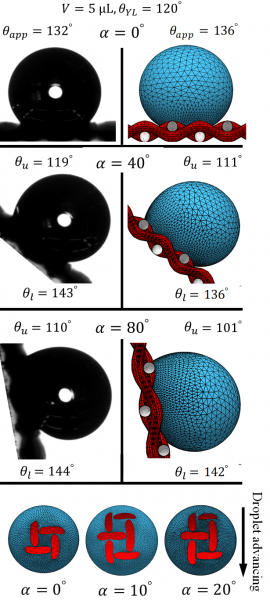
Comparison is made between the roll-off angle obtained from our simulations with those measured experimentally for droplets with different volumes [Venkateshan and Tafreshi 2018]. Video 4: Droplet Penetrates through the 1st Mesh but Not the 2nd Mesh |
| We also studied to the force required to make a droplet penetrate into a thin electropun PS mat as can be seen in figure below and in Video 5. We also conducted numerical simulation for the same (see below). |
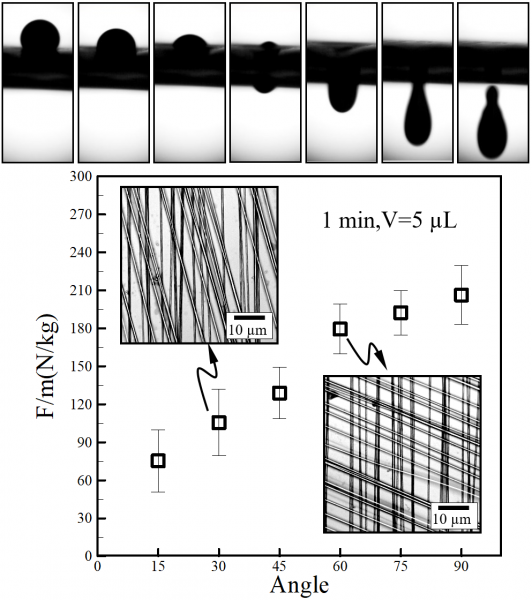 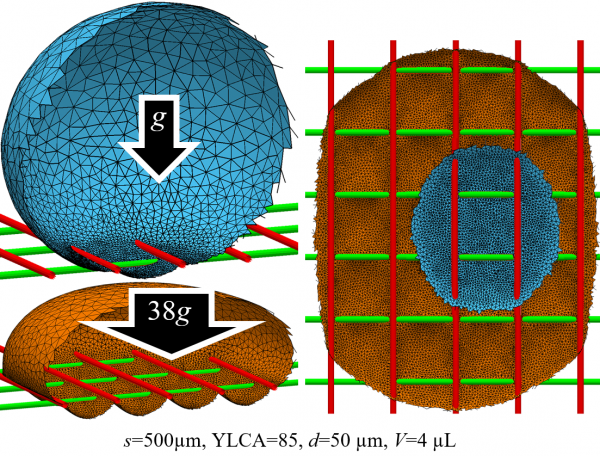
The figure to the left shows snapshots taken from a droplet magnetically forced to penetrate into a thin PS electrospun mat. The plot shows the effects of fibers’ orientation angle relative to one another on the force required to pull the droplet through the mat. The figure to the right shows examples of droplet profiles and footprints under the influence of gravity and at the moment of spontaneous penetration [Jamali et. al. 2019]. |
| We recently developed a new experimental method to measure the force required to detach a water (a polar liquid) droplet from a hydrophobic surface. This was done by partially cloaking the droplet with a high-surface-tension oil-based ferrofluid and using a magnet to apply a controllable body force to the resulting compound droplet (see figure below). This method is novel as the solid−droplet contact area is not contaminated by the ferrofluid. |
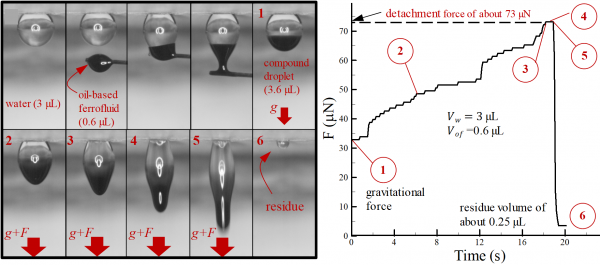 The left figure shows the process of adding an oil-based ferrofluid to a pendent water droplet and detaching the resulting compound droplet from an electrospun PS surface. The figure on the right is an example of the force trajectories recorded by a sensitive scale during the detachment experiment [Jamali and Tafreshi 2020]. |
| Our study was accompanied by numerical simulations aimed at unveiling the interplay between the interfacial forces in a two-phase droplet (a complicated four-phase interfacial problem conssiting of water, oil, air, and solid) under the influence of a strong (detaching) body force. Our study showed that the detachment force measured via partial cloaking is independent of the volume of the ferrofluid used for the experiment. |
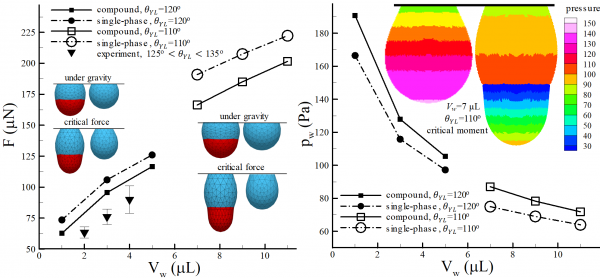 Comparison between simulated detachment forces for pure and partially cloaked water droplets is given in the left figure for different water droplet volumes and YLCAs. The figure on the right shows water droplet pressure at the water−solid interface vs water droplet volume. The inset figure shows pressure contours inside a water droplet with a volume of 7 μL and a YLCA of 110° with and without a ferrofluid cloak [Jamali and Tafreshi 2020]. |
Representative Publications:
|
Acknowledgement:
|
